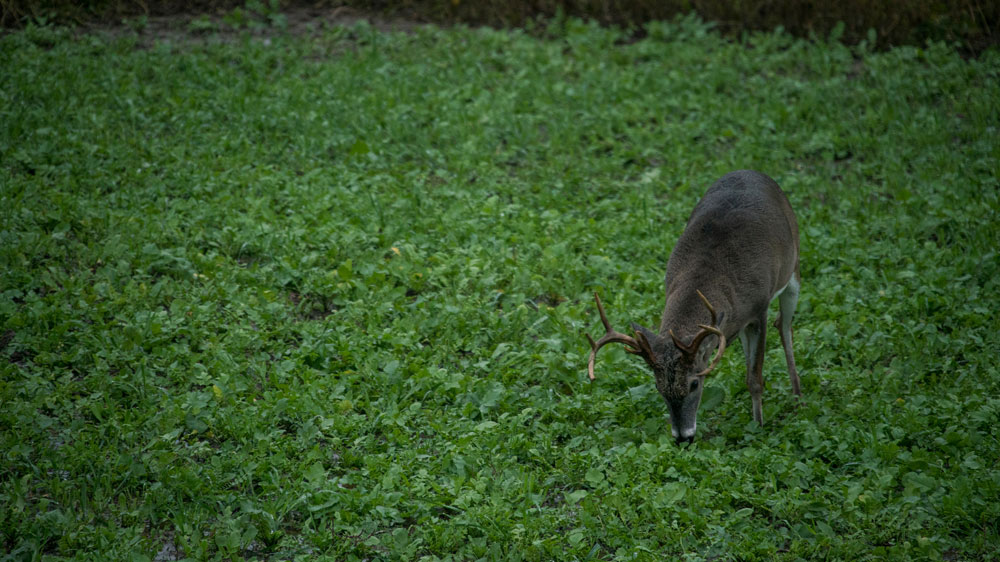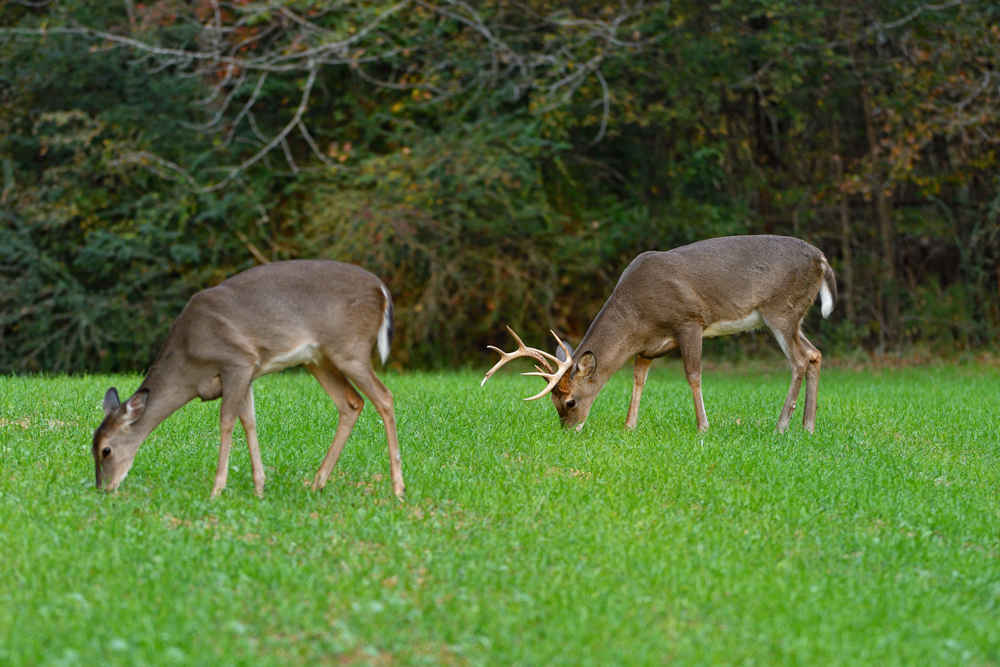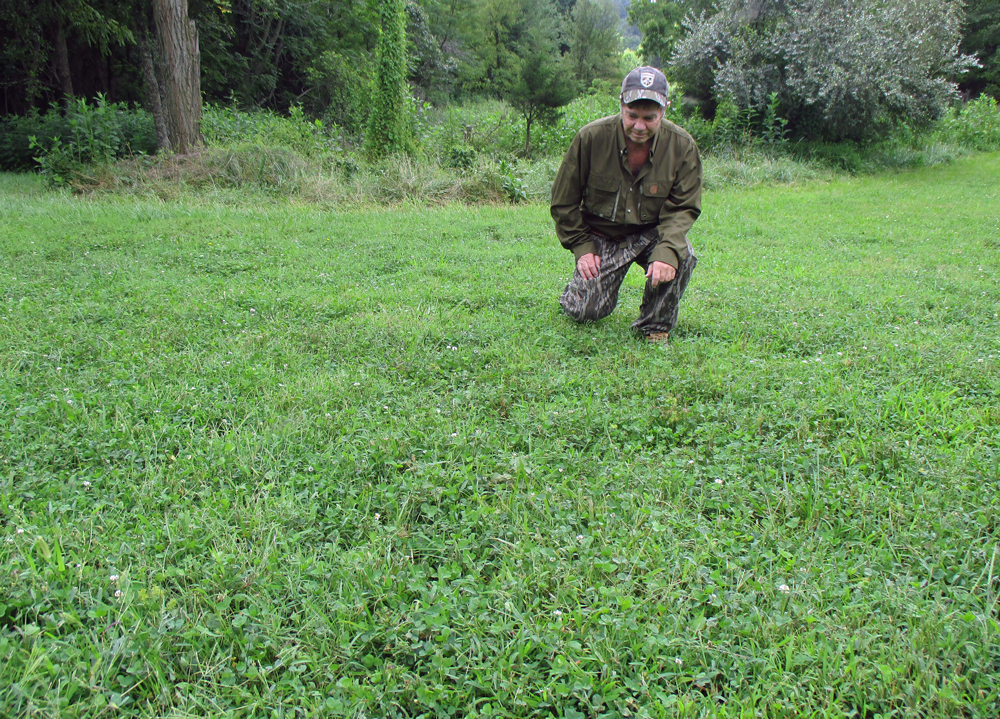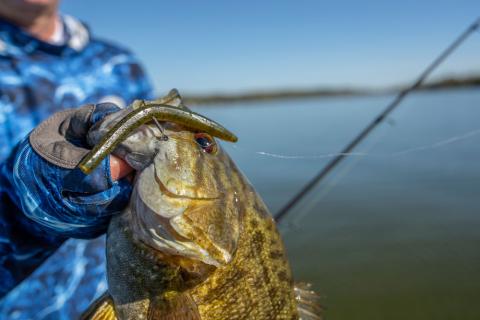Gerald Almy
By providing a consistent, high-protein food source, whitetails will have their best chance for reaching their full genetic potential. Airing on the Outdoor Channel | Whitetail Food Plots | On this episode of The GameKeepers of Mossy Oak we discuss the ins and outs of creating a successful food plot, why it’s important for your wildlife, and how to measure success.
Creating a year-round food plot plan
Picture the scene…you’re gathered around the dining table with family and friends for a lavish holiday meal. There’s a table full of all your favorites. An hour later, everyone has stuffed themselves and enjoyed the festive meal, but now someone begins clearing the table of the carved up ham, turkey carcass, and bowls of gravy, dressing and deserts. The pies are put back in the kitchen—if there are any left and suddenly, like a light was switched off, everyone scatters to other parts of the house. The dining room is deserted. The food is gone! There’s no reason to stay.
Sadly, this analogy shows how the deer population has it on a lot of properties. Hunters serve up hearty portions of prime forage, but only from late-summer into early-winter, to coincide with hunting seasons. At the end of that period the food has either been eaten, declined in quality, or been buried in snow. Worse yet, the field may even be plowed under and left fallow until the following summer.
Unless there are other things keeping the herd there (food, cover, sanctuary), once the food is gone, the mature bucks will be gone, too. They have large, energy-burning bodies that require, at times, up to 8 to 12 pounds of food per day. When the “food plot” table is empty, the deer leave, just like the guests at the dinner table when the food is gone. They have no choice; they must find nutrition somewhere.
As most of us know, deer need the formula of food, water, cover and sanctuary (The “FWCS formula”) to call a location their home. The last two aspects of “cover” and “security” go hand in hand, and are often influenced by pressure, or lack thereof. We want to offer the animals as many of their needs on our property as possible. Obviously on small properties or in certain situations it might be impossible to provide everything they need, but cover, safe areas, and water sources are needed.

This leaves the fourth part of the puzzle; “food.” While we may think we are doing a good job there, sometimes gaps may develop throughout the 12 months of the year. Maybe the crops have declined in nutritional value or been harvested, been covered in deep snow, or worse, been plowed under and the ground left fallow.
This dire situation of “food lacking for wildlife” typically happens during late-winter or early-spring, however, summer can be a tough time, too. If there is ANY period when a property does not offer high-quality food, they’ll simply move somewhere else to find it. And they might wind up hanging from a rafter in your neighbor’s barn.
This is a situation as gamekeepers should desperately avoid. Providing food for 365 days a year is vital to keep bucks on your land all year. It’s important for two major reasons. It allows you to protect them from neighbors who might think a two-year old buck is a good deer to shoot. It’s also important because it provides the nutrition needed for the animals to reach their maximum growth in body weight and antler mass.
A lack of nutrition during even one period of the year can severely degrade a buck’s ability to reach its full potential. If several months go by without high-quality forage being available, the damage can be serious. Countless studies have shown this correlation in both penned and wild deer. And it starts even before birth. Lack of quality nutrition for the unborn deer in a doe’s womb starts young animals off at a lower level than those born from does with all their nutritional needs met 12 months a year. Remember that natural foods, after all, average only 7 to 11% in most areas. For a buck to show you his best set of antlers he will need a year-round diet of 16% protein or better, and does require protein levels over 20% at times, especially when producing milk.
Whether you’re talking about a hot day in August or a snowy, frigid morning in January, it’s imperative to have high quality food available. Sure, native foods are important, protecting and enhancing these native plants is fundamental to a sound food program. But as gamekeepers, one of the best things we can do to provide high quality nutrition is to have quality food plots available 12 months a year.

Some studies estimate 80 percent of those who grow food plots only focus their efforts on attracting deer during the hunting season. That’s definitely understandable; after all, that’s why some of us originally turned soil for the first time. Drawing deer out of thick cover and into shooting range was the original purpose of food plots for many of us. Cereal grains and clover were the two go-to offerings typically used in my area, and both performed that chore admirably.
But food plot options have expanded tremendously since those early days. Now products are available to address all seasons of a whitetail’s nutritional needs.
As you read this Winter issue of GameKeepers, chances are you may feel pretty confident about your food plot offerings. Most habitat managers are good at providing superb plots for fall into early winter. Some even have a few perennial clover plots thrown in to take a stab at providing a year-round program. At first it may seem like enough.
That’s the way I felt early in my early years as a food plotter. I would have wheat and oats, sometimes mixed with annual clovers, plus perennial clover plots or occasionally alfalfa. “Seeing deer” was never a problem in these fields. The cereal grains would last well into winter. Then perennial clovers would thrive 10 months a year where I live in Virginia.
But then the snows came. In one particular storm 38 inches tumbled from the sky. It was lockdown. My wife was worried she wouldn’t be able to make it to town for several days until the snow plows cleared the roads. I was worried about my supposed year-round food plot program. My clover, wheat and oats were nowhere near reachable to the deer, no matter how determined they were.
I try not the blame myself. But one of the biggest bucks I’ve ever had the pleasure to nurture and watch grow on my land, a deer that in his prime reached 170 inches, died in that storm. (Sheds were found and measured each year.) I discovered him curled up in the woods, unable to fight through the deep snow to reach the distant plots and then dig down to find the low-growing cereal grains. Instead he stayed bedded and died in the storm.
That deer was old and his time was growing close even without the deep snow, but I vowed then and there to have more plots and different crops in strategic areas - crops that would stand up to snows and grow tall enough for deer to reach them. For me, that would turn out to be mostly brassicas and radish, but we’re getting ahead of ourselves.
Another stressful period in the nutritional life of a deer is during summer, when many landowners devote themselves more to fishing and sipping cold brews than habitat work, most hunters believe that with all the green vegetation growing, things must be OK for whitetails. It’s true; natural foods come out with a flush of bright green color and high nutritional content in spring, but by early summer the quality of natural forage declines rapidly.
Many gamekeepers ignore this period for food plots, except for perhaps a perennial clover or alfalfa plot or two. Even though these perennials can be valuable, they too, can become stressed and their quality diminishes during extremely hot, dry periods. In fact, palatability declines steadily with perennials after the first flush of growth, once the plants become taller, start to flower, and competing weeds and grasses emerge. This is one reason why mowing them can help, it establishes new, more tender growth. That’s when warm season annuals are the answer.
To get close to providing food for the majority of the year often the two missing links for most people are providing brassicas for late winter or snow-covered conditions and warm season crops like lablab, cowpeas, and forage soybeans for late spring and summer. These will help to grow the biggest bucks and healthiest does.

Certainly fall and early winter plots of cereal grains and annual clovers are great, but it’s vital not to ignore the snow-covered periods of late winter and early spring before green-up and the scorching heat of summer. Fill in those two gaps with the forage choices listed above and your property will indeed become a model for the ultimate year-round whitetail nutrition program. Sure there are other things you can add to the program, but the basics are listed below.
Where legal, you can also add feeders with protein pellets to your program, but they aren’t vital if you can provide enough acreage in brassicas, cereal grains, perennials and warm season annuals. Most nutrition gaps should be covered. At the same time, one should also consider bolstering their native plant food production.
You can mix and juggle what exact plants to use, and when you plant them will vary with the crops you choose and your location, but a 12-month food plot program including all four of these components will get the job done no matter which plants you go with, as long as you provide enough of each.
Perennials
Perennials are like “insurance” in a way. Put them in, mow them and keep them relatively free of weeds, and you’ll have a good foundation for the rest of your food plot program. They’ll green up between February and early May and provide a rich source of high protein food at that time of year, even before many native plants begin to produce well.
Depending upon your location north to south, they may remain a great source of nutrition during the summer (northern tier of states and Canada) and through the fall. In the transitional states and south, they are almost a year-round planting, though summer is a weak period because of the heat. You will likely get a good spring out of them, but they may go dormant during the hot, dry months and then perk up again during late summer and fall.
Non-typical Clover is one of my favorites with its big Critical Mass leaves. But Clover Plus and Alfalfa are also good choices. These cultivars can almost never be eaten down so badly that they won’t bounce back.
Care is simple. Treat them with selective herbicides and mow periodically (at least three times during the growing season. These stands will expand through stolon production and usually don’t need to be re-seeded.
Warm Season Annuals
A big challenge in providing year-round food is summer heat, and drought. Cow peas, forage soybeans, and lablab get the workhorses here. These plants will produce high levels of protein and massive amounts of food. Some will also produce seeds (beans or peas) in fall if the deer haven’t eaten them down.
These plants tend to be fragile when they emerge from germination so they need to be sown when soil temperatures first reach around 60-65 degrees. This will typically be April through June depending on where you are south to north.
They can be planted by broadcasting or drilling and sometimes mixing them with sorghum or sunn hemp provides a cover-crop and “anchor plant” for the “vinous” beans and peas to climb, in addition to another source of forage. Biomass all Legume is one of my favorite warm season annual mixtures.
Protecting young plants is vital. You can do this with electric fences, double fencing, or ribbons soaked with P2 Plot Protector. Another option is to plant so many acres that you “overwhelm” the deer and they can’t destroy enough young plants during the first few weeks to set them back appreciably.
Cereal Grains
Cereal grains that many old-timers turned to religiously for hunting time attraction are also worth planting. They’re especially appealing as the fast-growing plants first emerge and grow about 3-6 inches tall. They’re tender during this stage and have good protein levels. A strategy I like is to mix them with annual clovers for more palatability, browse-resistance, increased protein and a bit of a soil amendment. Be sure to plant cereals thick enough, so a deer can get a mouthful each time it takes a bite. You want the plot lush and thick.
With a robust herd of deer, they’ll typically keep these plots browsed down and coming back into the prime height for palatability and feeding. If you don’t’ have enough deer, you can mow them down periodically to encourage new, tender growth.
Brassicas
If you live in the transitional states or north, you can have deep snow any time from November through March. Brassicas like rape, turnips, radish and kale shine during the fall and winter. To be a feasible food source, first and foremost it must be “accessible” to the herd. Besides corn, brassicas are one of the only other choices. When I attended the State University of New York at Binghamton, we didn’t see the ground from Thanksgiving until Easter.
So there’s a crucial need for something stronger and standing taller than wheat, oats, and clover. That answer was brought to our industry by Mossy Oak Biologic many years ago, when they came out with brassicas for deer and more recently added radishes. Today, even in areas that don’t receive much snowfall, these plants should be a major component of any year-round food plot plan. They’ll offer high protein forage in their big, blue-green leaves starting in July or August, but become an even stronger attractant after cold weather and frosts turn the starches in the leaves to sugars. And their forage production is unreal at up to ten-plus tons of forage per acre.
Deer eat them fervently, often choosing them over all other foods during October, November and December, but it’s after that when brassica plots become even more important, especially in areas that get significant snowfall. And the benefits of these plants to the soil could fill a whole article, from suppressing weeds, to preventing erosion, to aerating the soil, and releasing glucosinolates that suppress harmful nematodes.
While there are other crops that may be planted and some specialty plants that may work in certain areas or under specific conditions, these food types make up the “four corners” and the foundation of a year-round program. Make these four forage groups available for the deer on your property and you’ll be well on your way to providing a year-round menu that will keep deer fat and happy, and if you have their other needs covered they will be unlikely to leave your land. A sound year-round food program is a key to helping them reach their full potential in both, body weight and antler growth.
What Seed Should I plant In My Food Plot?
There's a lot of different blends out there, a lot of different seeds you can look at. We're planting cereal grains, brassicas some annual legumes like winter peas, but for the most part the workhorses are going to be cereal grains, oats, wheat, triticale, things like that, or brassicas, which would be turnips, radishes, Usually considered high energy high carbohydrate top food sources that provide really good food, really from the mid part of the fall on into the winter, that's when we really kind of concentrate on those brassicas being the most beneficial to our deer harvest.
Why Should I Plant a Spring Food Plot
When I plant a spring food plot, it's about providing high protein, nutrition, through the growing months. Your deer have dropped their antlers in the late winter - early spring. They're fixing to start growing a new set. You've got does that are starting to grow one, two, maybe as many as sometimes three fawns. They really need a lot of good nutrition to get those fawns started off to really good early start. That spring time growing season is where the key is to provide as much nutrition and overwhelming them with as much higher protein forage as they can get during those critical months.
When Should I Plant A Food Plot?
The best advice I give guys for a fall planning is, whether it be radishes or a brassica blend with cereal grains, we're looking to try to get those in a solid 45 to 60 days before your first average frost. That's really easy find through Farmers Almanac, obviously, Google will help you out a ton on what your average frost date is. We want to make sure that I've got enough time to establish a really solid root system, and provide enough forage that will last you through the fall in the winter. There's a little bit of a misconception that frost kill a lot of your fall food plots and that's really not the case they just slow the growth process way down. The photo period starts getting shorter you know your length the days. So your, your growing process slows down considerably usually once the frost sets in.
What's Your Favorite Food Plot?
Brassicas are our favorite crop the last into this kind of weather we've had freezing weather it's still green out there and the brassicas make more tonnage than almost any other crop you can plant. So if you have a high usage on it and want it to last, the best time here in Minnesota to plant radishes, July, 15, you'll get enough growth to get a decent root growth as well as top growth.




























